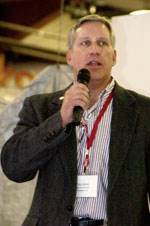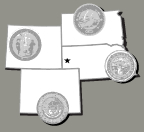The Future Structure of Beef Production
by Troy Smith for Angus Productions Inc.
MITCHELL, Neb. (Nov. 29, 2011) — Tom Brink thinks owning beef cows might be a good idea, for the present and into the future. Formerly with CattleFax and now associated with JBS Five Rivers Cattle Feeding, Brink spoke on the opening day of Range Beef Cow Symposium XXII in Mitchell, Neb., sharing his observations regarding structural changes occurring in the U.S. beef supply chain.

Stocker operators have been having a lot of fun, thanks to a 10-year run of profitability, said Tom Brink. Brink called the current situation unique in the history of the beef industry.
Beef demand is growing, while supply is shrinking. Prices are rising and showing no sign of stopping, despite reaching record highs this year. Brink thinks cow-calf producers may, during the next five years, see some of the best profits they have experienced in decades.
Stocker operators, said Brink, have been having a lot of fun, thanks to a 10-year run of profitability. High corn prices have increased costs of gain in feedyards, resulting in increased placement of yearlings and decreased demand for calves. Smaller price spreads between calves and yearlings have resulted in more favorable purchase-to-sale relationships for the stocker segment. In regions where byproduct feeds are abundant, their use has helped stocker operations hold down production costs.
“It’s an advantageous situation for the stocker segment,” said Brink, calling it the only cattle segment that is growing, as some feedyards and cow-calf operations have shifted to stockers. “If you can put 200 pounds (lb.) on a calf for less than $1.10 per pound, it can be profitable,” he added.
Brink said it is likely that yearling placement will continue to increase. He looks for calf placement to decline by 20% during the next couple of years, with yearlings weighing 750 lb. or more comprising nearly half of all feedyard placements.
That could make it more challenging to maintain beef marketing programs tied to ranch of origin, since more calves may be purchased and grown by stocker operators, rather than going directly to feedyards. Brink said breaks in the linkage between packers, feeders and cow-calf producers, along with relaxation of animal age restrictions associated with beef export markets, could diminish opportunities to garner premiums for age and source verification.
But Brink thinks cow-calf producers can expect good times, provided their cost structures are favorable and they can sell calves at prices equal to the market average or higher.
“To me,” stated Brink, “it seems like a pretty good time to own the factory.”
The biennial Range Beef Cow Symposium was hosted Nov. 29-Dec. 1 at the Mitchell Events Center, Mitchell, Neb., by the cooperative extension and animal science departments of the University of Nebraska-Lincoln, South Dakota State University, Colorado State University and the University of Wyoming. Comprehensive coverage of the event is provided online at www.rangebeefcow.com, an event coverage site provided by Angus Productions Inc. (API), publisher of the Angus Journal and the Angus Beef Bulletin.
Editor’s Note: API's coverage of the event is made available for distribution to all media via an agreement with the Range Beef Cow Symposium Committee and API. Headquartered in Saint Joseph, Mo., API publishes the Angus Journal, the Angus Beef Bulletin, the Angus Beef Bulletin EXTRA, and the Angus e-List, as well as providing online coverage of events and topics pertinent to cattlemen through the API Virtual Library. For questions about this site, or to notifiy us of broken links, click here.

